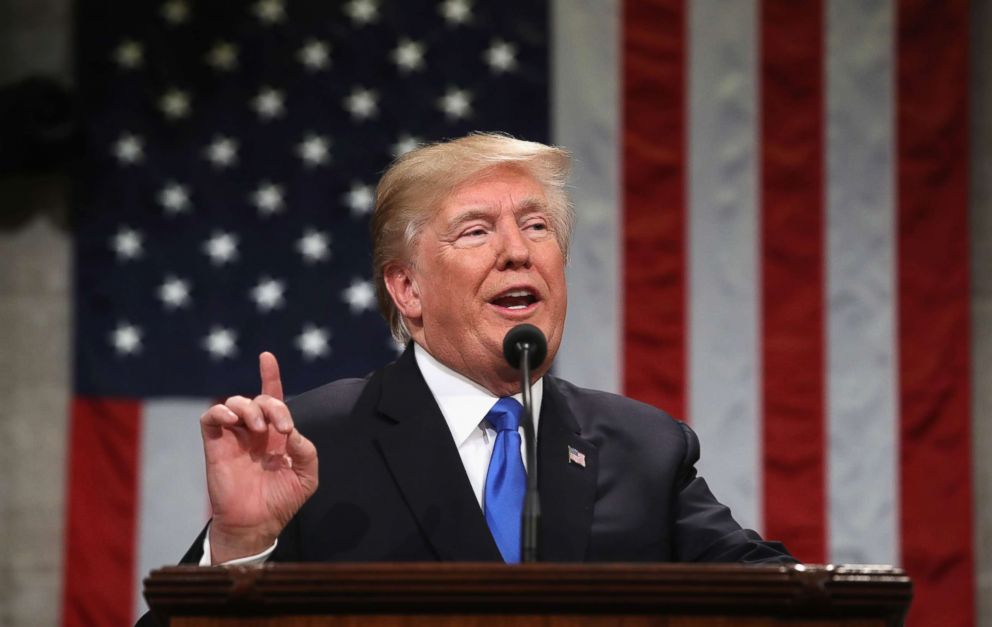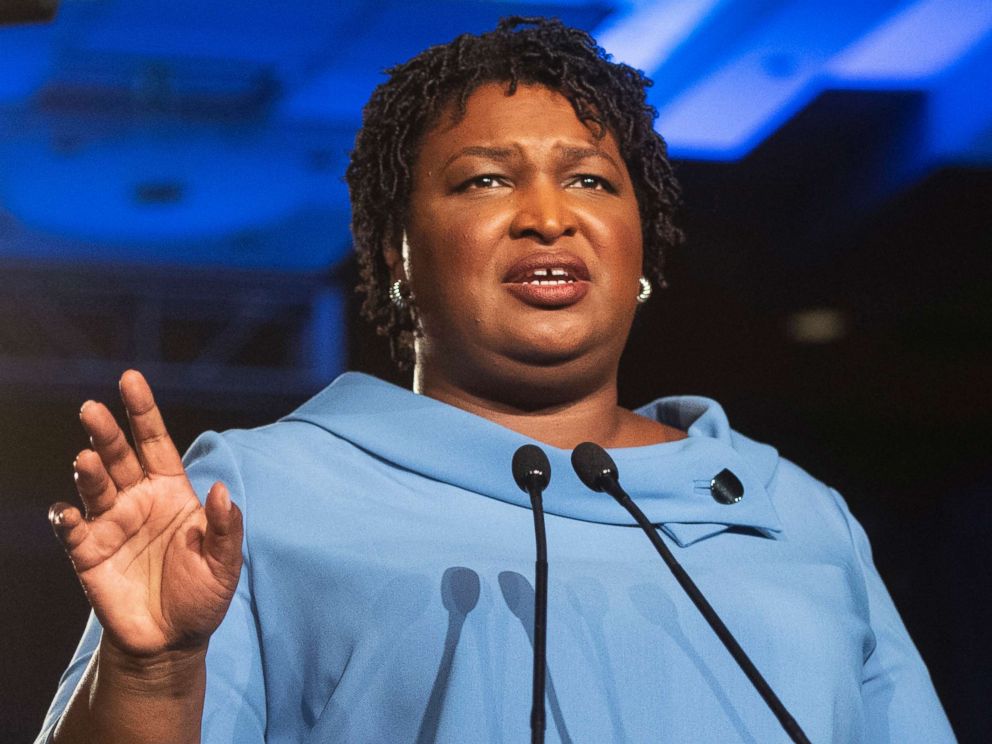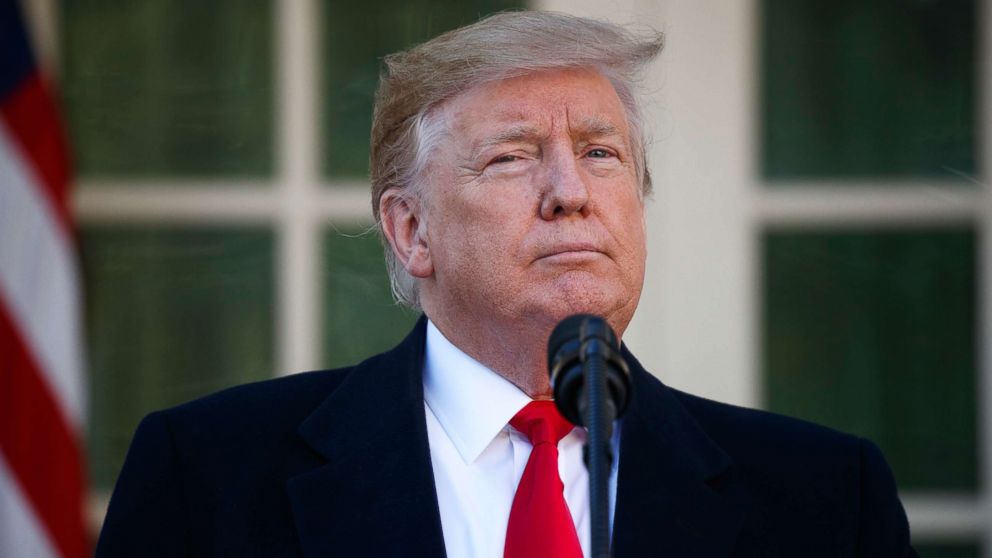[ad_1]
President Donald Trump on Tuesday night will give his second State of the Union address, one week after he originally was invited to deliver it but didn’t because of the longest-ever government shutdown.
Trump and Congress are in a particularly tense period. It’s been just a week since the government reopened after a 35-day shutdown that caused some 800,000 federal employees to go without paychecks and shuttered nine federal agencies. While the government is open now, it could shut down again in 10 days if the president, the Democratic-controlled House and the Republican-controlled Senate don’t come to an agreement on border security, which Trump demands must include billions of dollars for a wall along the southern border.
The president, according to a senior White House official, is expected to discuss immigration in his speech along with other topics seen as key parts of his agenda: middle-class American workers, improving infrastructure, lowering the cost of health care and prescription drugs, and national security.
Trump will speak for the first time before a divided congress. Last year, the Senate and House were controlled by the president’s own Republican party. This year in the House, Democrats hold 235 seats to the Republicans’ 199 seats. Republicans hold 52 seats to the Democrats’ 47 seats in the Senate.
Trump not expected to declare state of emergency in State of the Union speech
With a day full of speech prep ahead of him, the president sent his first tweet of the morning Tuesday indicating his focus is set squarely on his demand that Congress fund a wall along the U.S.-Mexico border.
Tremendous numbers of people are coming up through Mexico in the hopes of flooding our Southern Border. We have sent additional military. We will build a Human Wall if necessary. If we had a real Wall, this would be a non-event!
— Donald J. Trump (@realDonaldTrump) February 5, 2019
According to White House officials, the president as of Tuesday morning was not expected to make any official national emergency declaration, as he has threatened, in a move to obtain funds to build his border wall without congressional approval. And while the president won’t explicitly rule out another shutdown, one senior official tells ABC News that his address is “more of a unifying speech, saying he actually wants to get things done.”
Trump warned on Sunday that if Democrats and Republicans can’t strike a deal to fund the government by the Feb. 15 deadline that includes wall funding, he could go it alone by declaring a national emergency, though Republicans have warned against it.
But White House counselor Kellyanne Conway told reporters at the White House Tuesday that the president will express to lawmakers that he prefers they appropriate the funds he is demanding for securing the border, rather than forcing his hand to take unilateral action.
“The president has said that he can do it,” Conway said. “But he’s never wanted to do that. He wants Congress to finish its work. He wants them to put a deal on his desk that he can sign.”
The shutdown left more Americans blaming Trump and the Republicans in Congress than House Speaker Nancy Pelosi and the Democrats, 53 percent to 34 percent, according to recent ABC News/Washington Post polling.
What is Trump expected to cover?
The president will talk about immigration, a major focus of his administration and a subject he covered last year when he suggested a “four-pillar” system in which “nobody gets everything they want, but where our country gets the critical reforms it needs.”
The pillars, which didn’t come to fruition in Congress, included a pathway to citizenship for “Dreamers,” the young undocumented immigrants previously protected by the Deferred Action for Childhood Arrivals policy ended by Trump last year, a wall on the southern border, an end to visa lotteries and a limit on family immigration sponsorships.
Conway also confirmed to reporters that Trump will be using his address to outline a strategy for ending HIV transmissions in the U.S. by 2030.
“I look at that as a nonpartisan issue and the president does also, so he will be asking for bipartisan support to make that happen,” Conway said in response to a question from ABC News.
This year, the speech likely will be even more targeted as meetings are underway between the Republicans and Democrats on the exclusive committee charged with negotiating a bipartisan border-security funding proposal.
 Win McNamee/AFP/Getty Images, FILE
Win McNamee/AFP/Getty Images, FILETrump also is expected to hit on the economic woes of working-class Americans — a major campaign platform of 2016 and also a focus of last year’s speech. He’ll narrow in on trade deals, like the one his administration is working out with China after trading tariffs over the last few months, and urge Congress to approve the United States–Mexico–Canada Agreement, according to a senior administration official.
Trump plans to discuss infrastructure, which he asked Congress to generate $1.5 trillion for in last year’s speech, health care and the high cost of prescription drugs and national security, said the White House official. The president will specifically address the political standoff between Venezuela’s opposition leader Juan Guaido and President Nicolas Maduro.
The White House classified this year’s speech as “visionary” — looking toward the future and presenting a “common-sense path forward” with a “very American and can-do optimistic approach.” It’s also going to be long, according to a White House official, following in the footsteps of last year’s 80-minute speech.
Who will give the Democratic response?
Stacey Abrams, the first African-American woman to be nominated for governor by a major political party, will add another historic first to the list attached to her name when she delivers the State of the Union response on behalf of Democrats.
Abrams will be the first African-American woman to give the speech responding to the presidential address, according to all archival research on the speech from both the House and Senate historian offices.
And even though she lost the tight race she ran for Georgia governor last November, Abrams was nevertheless selected to be the face of the party in a speech that will be seen by millions nationwide — a testament, experts said, to the power Democrats believe Abrams holds to connect with a diverse electorate in a moment of American politics increasingly enveloped by the complexities of gender and race.
Moreover, in the aftermath of reports of racist photos involving Virginia’s Democratic Gov. Ralph Northam, Abrams’ words will increasingly be in the spotlight.
“It’s crucial for the Democratic Party at this point to decide what sorts of voices they want to represent and what sorts of inroads they want to make as far as the party being optimally inclusive,” said Jamila Michener, a professor at Cornell University who studies racial inequality and electoral systems.
 John Amis/AP, FILE
John Amis/AP, FILEWhat’s different from last year?
The audience will be bluer and less red, but on the heels of a November election that brought in a historically diverse Congressional class, Trump will be delivering his address to a House chamber filled with more women and people of color than ever before.
To acknowledge this historic diversity, many lawmakers will be wearing white, a nod to the women’s suffrage movement. House Democratic Majority Leader Steny Hoyer is planning to hand out white lapel ribbons for his male colleagues to wear in solidarity with the women wearing white.
The effort, Hoyer said, “sends a respectful message that House Democrats stand with women across the country and will continue to defend their rights.”
At least one lawmaker, Rep. Bobby Rush, D-Ill., plans on joining his female colleagues in wearing all white.
Last year, in an effort to protest Trump’s policies, 14 Democrats boycotted the address. So far this year, only five Democrats have publicly announced their decision not to attend, including Georgia Reps. John Lewis and Hank Johnson, as well as Oregon Rep. Earl Blumenauer.
“Just like in past years, I plan to skip a speech that will be filled with lies, deception and divisiveness,” Blumenauer said in a statement.
Many of the diverse freshmen House Democrats are using their attendance to make political statements. New York Rep. Alexandria Ocasio-Cortez teased the announcement of her guest, Ana Maria Archila, in a Twitter post, showing a pin she bought for Archila that reads “Well-behaved women rarely make history.” In September, Archila confronted then-Sen. Jeff Flake, a Republican from Arizona, about sexual assault on an elevator on Capitol Hill during Supreme Court Justice Brett Kavanaugh’s Senate confirmation hearings. Attention from the video of the encounter led Flake to temporarily hold up the vote for Kavanaugh and ask for an FBI investigation into allegations of assault.
Two other groups expected to be represented among State of the Union guests are transgender service members and environmental activists.
At least four lawmakers have announced their guests are either active-duty or veteran transgender service members. Trump’s plan to restrict service by transgender men and women is currently held up in the courts.
And several Democrats have announced that their State of the Union guests are activists from communities impacted by environmental contamination from a type of chemical used in Teflon and firefighting foam. Lawmakers from both sides of the aisle have expressed concern about whether the Environmental Protection Agency will limit the amount of those chemicals allowed in drinking water ahead of the expected release of a national plan to deal with them.
One thing that’s not new?
Former presidential candidate Sen. Bernie Sanders also will deliver a response to Trump’s State of the Union address Tuesday night, something he’s done three years in a row, through a live stream on social media. He’ll speak after Abrams.
ABC News’ Alexander Mallin and Stephanie Ebbs contributed to this report.
[ad_2]
Source link

